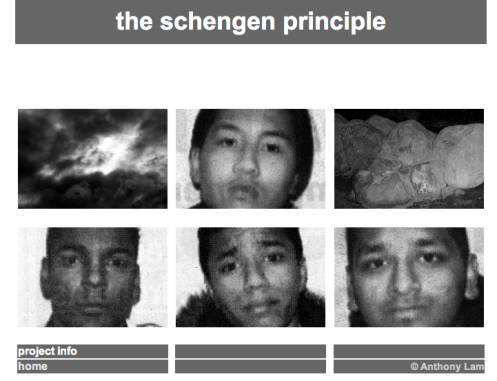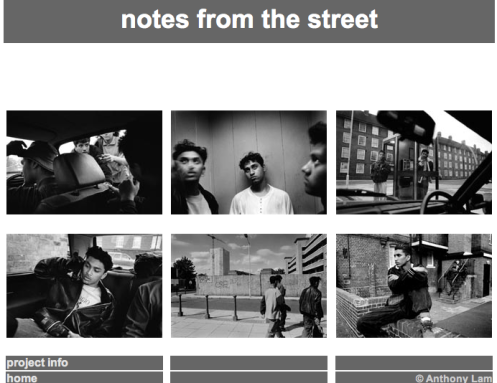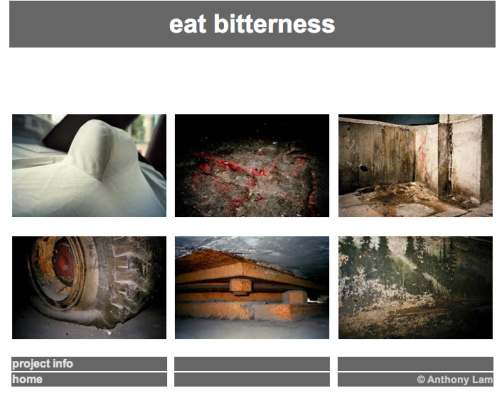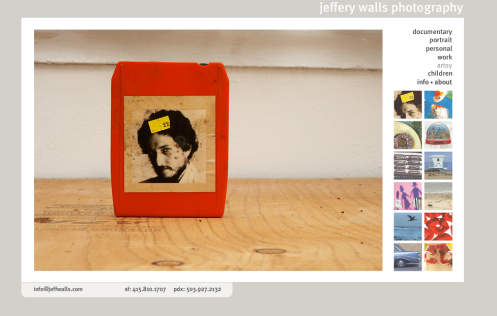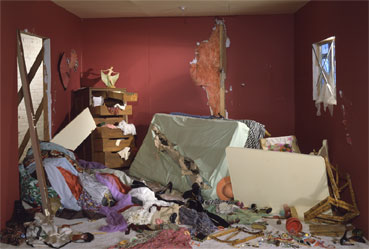anthony lam – interview 15/03/12
Anthony Lam
Work references used in interview
- Eat bitterness – hardship for the good of the nation
- Notes form the street
- Port of call
- Solid turbulence
Anthony Lam is a photographic artist whose work examines and explores notions and (un)realities of boundaries and borders. A conceptual framework of difference, dislocation and detachment informs his projects and are themes that he actively engages with and pursues. Lam’s diverse practice is located within representational and social concerns, addressing issues of identity, culture and place from a personal and socio political viewpoint.
- Your Photojournalistic style – Is it art? Conceptual photography? Social commentary? Fine art photography?
Paul graham – – post doc photography. – http://www.paulgrahamarchive.com/
Personal reflection in the work
Social commentary yes –
1st instance in itself of interest without any other layers – complexity – read diff levels
Has photo journal look – but now as entered into gallery can be shown / context shifts…
Eat bitterness –
Narrative – eat bitterness – not strict narrative – limitations of photo doc – creating meaning with the style of images already
Work develops to the reaction to the narrative…
Meaning comes from the particular way its photographed – prescribed what the meaning is..
Closed/macro view – context/presented/framed- gives openness to it, ambiguity, question it more…
Derive yes, but focused areas – place or social – they define an area..
Turn on photographer button – sometimes nothing happens, absorbing, embedding the feelings/thinking… then a moment [signature picture] then it starts etc
- Do you look at these commissions/projects as principally personal creative outputs or is the message to be ’read’ more important?
Solid turbulence –
Commission – how will photographical do it, then research the area, them methodology/approach to responding… sometime self initiated, but then sometimes a brief… but tear apart and present re-brief differently..
Allow to be challenged and explore ears you would not
- If social/political commentary why are some of the images quite so ‘conceptual’ – solid turbulence – how many passengers do you think really got your purposed meanings? Are you expecting them too?
Set in old railway arch.. not grand setting.. such strong juxtaposition, they will react, but as far understanding ?/ terms of the interviews they got it… hard to determine the response…
Not obviously critical of the areas… cloud shots… heaven/hell.. etc they might have got it, muslims, jews, – being provocative –
Quote form salvation army to give clues about the meaning…
Sometime the org that commission a have very simplistic or unknowing views about the actual community etc
- Your images are designed to question and challenge; also allows the audience to bring their own reading but if meaning missed or misread does it cease to work and therefore not fulfill the original brief, does this bother you ?
Eat bitterness – deliberately launched a gallery with julien stallbrass – helped having arts people there etc
Try to Disassociate from work, and how it actually brings people to the dialogue and get involved about the issues… rather than the personal responses
- Anti – photography technique? Often Unfussy, low quality cameras etc… are this to aid the ‘reality’ or more of a technique for something else?
No deliberate policy, not that interested in technique,
Distrust of highly polished imagery – assoc with commercial work
John gossard – the pond – video – doesn’t want the camera to get in the way of the image itself
Photographer John Gossage finds moments of grace and elegance in even the most mundane places. Join the artist and curator of photography Toby Jurovics for a conversation about The Pond and its role in the history of American landscape photography.
Not a conceptual – not dressing things up –
More about the content – if the contents are strong does not matter what you have taken it on
Likes flash – direct etc…
But like – Geoff wall –
Don’t want to labour it that much –
Just adding further descriptions to our life and the world around us –
Reflections on things he sees…
- Do you purposely want them to look ‘unworked’, naturalistic, immediate, and instant? What effect do you think using a better camera and longer set ups would have had on the form, context and projected reading?
answered in other question
- Seems to be this immediate, instant style in many projects – this reflect you, your perception of photography, your perception of the context, the perception of the potential audience? The need to react quickly to the environment?
answered in other question
- What are your criteria for selection of images?
Print out, 1st election, come back… sometimes show the edits…
Eat – closeness was the style , intense , close ups
Did have people too, but was not what wanted to reflect… not appropriate for this work, often repetition..
William eglestone – takes a picture , not sequence… liberating??
Must be a series, not isolated images – allows inflections and openness
- View on Narrative? Often seems defragmented, subtle ? why?… is it a personal view on context or the nature of photographing things?
Mostly loose narratives, don’t want end to be telegraphed… as viewer – like the ones I don’t know where its going, change the order, look as one or all, relationship changes when viewed differently..
- What directs you when searching for the images?
answered in other question
- Often Purposely being subversive?, seeking the ‘ugly’, the ‘un-beautified’, finding beauty in what others would see as banal? Do you consider yourself a surreal photography –
As Susan Sontag writes in her book ‘On Photography’ [1978], that the surrealist’s perception was:
‘directed to finding beautiful what other people found ugly or without interest and relevance – bric-a-brac, the naïve or pop objects, urban debris’.
Everything has a beauty to it.. don’t know if I look at it consciously as ugly,
Tourist – unfamiliar, distance , objectify things, see things as the other – danger is producing a series of images that makes everything look beautiful in its ugliness – so not resolving the issue, but being a tourist… looking at world a mechanical process different to the way we would see it naturally .
- Seeking to represent what – reality, the real, your perception of reality, the ‘other’?
answered in other question
- Capturing Realism of content/context – reaction against polished ‘photography’, or fine art photography… always seeking to show ‘other’ in all its ‘real’ glory…
Once a photography taken, does it immediately change its original context, as its your re-presentation of the scene? Now disjointed from the next moment in time, excludes the surrounding mise en scene, distort the viewers perception or potential understanding of the situation?…
Gary winnagram – takes photo to see how they look as a photo…rather than how see it when taking the photo … then apply an intent – each person takes what they want.
- Does The act of taking a photograph always beautify the content? Embellish it with layers of meaning that are not necessarily there in actual reality?
answered in other question
Walter Benjamin in ‘The Author as Producer’ [1943], observed that the camera:
‘is now incapable of photographing a tenement or a rubbish heap without transfiguring it… in front of these, photography can only say ‘how beautiful’… it has succeeded in turning abject poverty itself, by handling it in a modish way… into an object of enjoyment’.
- How does the photographing a crack in the wall, a stain on carpet, a broken window etc change its perception from just seeing it with normal vision in normal life?
John Berger in his book ‘About Looking’ [1980] writes:
‘a photograph is not only an image, an interpretation of the real; it is also a trace, something directly stenciled of the real; like a footprint or a death mask’.
answered in other question
- Why does it then seem to have more impetuous, importance, because we, as photographers, as deemed it of importance, or is it the way we actually ‘look’, interact, interrogate at photographs…
John Berger in his book ‘About Looking’ [1980] writes:
‘a photograph is not only an image, an interpretation of the real; it is also a trace, something directly stenciled of the real; like a footprint or a death mask’.
answered in other question
- Do you try to predetermine an audience effect when creating the idea for the work, ordering, grouping etc. of your images?
No – happens during, crystalized after.. comes as photos taken…
Leave space for yourself, challenge yourself as well as viewer to make it interesting..
- Is the ‘process’ of the work more important than the actual output?
Yes, process it remembered, not expecting viewer to know/experience
– don’t want process to deconstructed… important to me, helps construct the work.
- How do you see your process manifesting itself, how is the viewer supposed to interact with your process ? any process?
answered in other question
- do you think the process needs to be understood for your work to be understood… do they work as standalone images? Are they supposed too?
answered in other question
- Is a preconceived knowledge of the subject themes needed to access your work fully ?
answered in other question
- Can articulating the process too much sometimes get in the way of the images readings? is all this sometimes missed, or imperceptible to the viewer ?
answered in other question
- When photographing people – ‘notes from the street’ – do you feel the camera makes that act in a none ‘real’ way? Different for the camera?
Is this then reality or a representation of it?
Cant capture 360 reality, editing out stuff all the time..
Just building up another view point…
Important for images to create dialogue…

